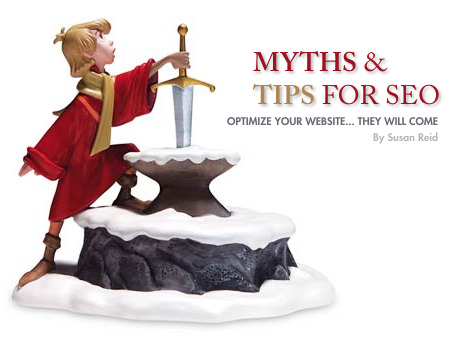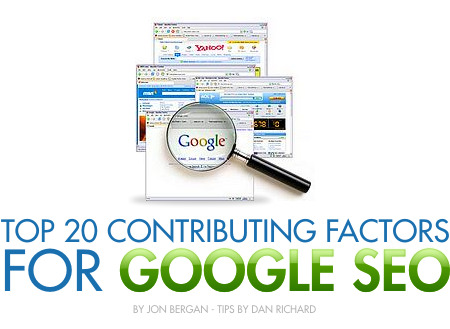Optimize Your Website – Myths and Tips for Website SEO
This was really a fantastic syndicated article I wanted to share… a great breakdown on the truths and myths of SEO, check it out:
What’s the big deal about search engine optimization? Isn’t it enough that you’ve put up a website, purchased some Google AdWords, and sent out an email to everyone you know announcing your site? In short, no. There is an art and science to search engine optimization (SEO), and it is critical for web-based businesses to know, understand and utilize if they want to drive quality traffic to their website via the Internet.
Where do you begin, though? How can you possibly know whom to trust or what to do first with so much information out there on SEO? Do you buy links or not? Pay per click or go organic? And what about those SEO companies who are aggressively promising Number 1 rankings? When it comes to search engine ranking, there are a lot of rumors and myths about what will improve your rankings and what won’t.
Debunking Some Popular Search Engine Ranking Myths
1. Pay per click (PPC) ads will either help or hurt organic rankings. (Organic simply means the process by which web users find websites having unpaid search engine listings.)
Debunked: PPC is categorized differently than organic listings. There is no effect, one way or the other, on ranking.
2. Websites are banned if they ignore Google guidelines.
Debunked: While it’s a good idea to read Google Webmaster Guidelines or Google 101: How Google Crawls, Indexes and Serves the Web, you are not banned if you ignore their guidelines.
3. Websites are banned if they buy links.
Debunked: Sites are not banned. The links just aren’t counted.
4. Copy must be a certain number of words, use a specific keyword density, and contain bold or italicized keywords.
Debunked: It used to be thought that there was a magic number of words used or certain times a keyword or keyword phrase should be repeated. Not so. Same with bolding and italicizing. They don’t do anything for ranking.
5. Duplicate content will get your website penalized.
Debunked: It will just get filtered out and not counted.
6. Reciprocal links won’t count.
Debunked: Every link counts, to a certain extent.
7. SEO companies can improve your rankings without doing any on-page work.
Debunked: Run if an SEO company tells you this.
According to SEO expert Jill Whalen, SEO isn’t magic and isn’t a crap-shoot. “SEO is about making your website the best it can be for your site visitors and the search engines.” Want to help the right kind of people find your website? Then you need to design your site so search engines can find, crawl and index your pages.
Pro tips!
Tip from Dan – Here are some additional Myths provided by www.mediumblue.com
There is an abundance of search engine information available on the web- some of it valuable, much of it contradictory. Throughout the years some prevailing search engine myths have developed. Some of these myths are still encouraged by companies with a financial interest in their continued existence. Others are based upon techniques that were effective years ago but no longer work. Still others come from simple misunderstandings that inevitably come with a relatively new medium. What follows is a few of the most prevalent.
Myth: Using a program or service to “Submit your site to 10,000 Search Engines” is a good idea.
Fact: There aren’t 10,000 search engines. There aren’t even 500. In fact, the top 10 search engines account for the vast majority of search traffic (studies vary from between 85 and 98 percent). Most of the sites that these programs or services list as “search engines” are called FFA (Free For All) sites, sometimes called “link farms”. These sites will agree to place a link to your site on their site, which is usually just a collection of links. Your link will usually only appear for a short time, since as new links are added, the older ones are pushed off the page. Almost no traffic can be expected from such links- but you can expect a lot of unsolicited mail to the email address that you provide them. In fact, these pages are set up largely to collect email addresses to which spam can be sent (and you can get spam for free!). In addition, engines do not like submissions done by computer programs (because of the excessive use of bandwidth and resources), and many of the most popular have taken steps to make automated submission impossible. This means that these programs or services will not even get you listed in many of the top engines.
Myth: Meta tags are the most important factor in search engine rankings.
Fact: Many search engines (most notably Google) ignore meta tags completely due to constant abuse by webmasters. The only importance placed on meta tags these days is actually the meta description tag, which will appear as the description for the corresponding page on engines that use inktomi data (such as MSN). Meta tags are virtually irrelevant in the ranking algorithms of the top engines- but many people continue to believe that they are the only optimization strategy that they need.
Myth: It’s impossible to do search engine optimization in-house.
Fact: It often is done in-house, and done effectively. This is typically when a large corporation hires in-house talent that is largely devoted exclusively to promoting the website. However, it is unrealistic to expect someone with many other job functions to do a credible job of SEO. Much of the skills are acquired through experience- and it isn’t usually desirable to have someone “experimenting” with the company website (especially considering that certain techniques can get sites penalized on engines or banned outright). SEO isn’t rocket science, but it also isn’t something that can be learned overnight. When deciding whether to outsource SEO or do it in house, it is important to consider the actual costs involved. Often, when the necessary hours it takes to pay someone to learn on the job are taken into account, it is cheaper to outsource (and the results are almost always better). Only a careful evaluation of your goals and resources can determine the best course of action for your company.
Myth: Sites must be constantly resubmitted to retain rankings.
Fact: This is a scare tactic popularized by various submission services and software companies. In fact, it is a waste of money to pay to have your site resubmitted once it is already listed in an engine’s database. It will not hurt your rankings to constantly submit (or else people would submit their competitor’s sites to get them penalized), but it will not help, either.
Myth: Search engine optimization is not as effective as “traditional” marketing.
Fact: In many ways, it is more effective. Companies often spend countless dollars on direct mail, television and radio advertising, and bulk email without a second thought. The common thread with each of these strategies is that the prospect is “approached” by the company, and that the company must reach a great number of people to find a few motivated prospects. On the other hand, search engines can deliver highly motivated prospects directly to your website- people who have already demonstrated, through their use of particular keyphrases, an interest in your products or services.
WARNING: Your site CAN be penalized by Google if you allow other websites to purchase links on your site and you do not employ the use of “nofollow” tags. Google has been penalizing website PR levels, and you can read all about it on my blog when it happened right on Pixel2life.com.
Seven Ways to Get Your Website Crawled
1. It’s better to have one main website with numerous domains pointing to the main domain, than to have mini-sites or multiple sites with similar content. Mini-sites and multiple sites with similar content do not increase search engine listings and are frequently viewed by search engines as SPAM.
2. If you do have several stand-alone websites, make sure each serves a different target audience and has unique content with different domain or sub-domain URLs.
3. Search engines need to be able to follow internal links. To make that happen, use tags, text links, image links, and CSS menus. Spiders have difficulty with JavaScript menus, pop-up windows, drop-down menus, and flash navigation.
4. Choose keyword phrases that are most relevant and specific to what your web page is about. Think from the perspective of someone searching for what you are offering on your site. Ask, as if you were they: What would I search for if I am looking for something on your page?
5. Validate your keyword phrases through either paid or free services, such as Keyword Discovery, Wordtracker, or Google AdWords.
6. Check for keyword competitiveness. Take into consideration the size of your business. In this case, size does matter. If you are a major player with a major brand, you can play in a larger competitive pond than a smaller company just starting out. Know what size pond is right for you, and check for competitiveness by putting: allintitle: “keyword phrase” in your browser and check the number count.
7. Once you have your keyword phrases validated and checked for competitiveness, use them in anchor texts, clickable image alt tags, headlines, body text copy, title tags, and meta descriptions. Meta tags aren’t all that important for crawling.
SEO can be both intimidating and exhilarating. Intimidating because it seems as if just about everyone has an opinion on what it takes to get a high ranking in Google, so it’s hard to know what to believe. Exhilarating because, once you understand the method behind the madness of SEO, you see the art and science of it. Then it becomes fun and easy to come up with a strategic plan about where to place keyword phrases, how to write copy, and what size pond is best for your company to compete in. Optimize your website, and they will come.
About The Author
Dr. Susan L. Reid is a business coach and consultant for entrepreneurial women starting up businesses. She is the Award-winning author of Discovering Your Inner Samurai: The Entrepreneurial Woman’s Journey to Business Success. Susan provides intuitive small business solutions, powerful attraction marketing tools, inspiration, and direction. Visit SuccessfulSmallBizOwners.com and download your copy of her latest free business success article.
Hope you enjoyed!
Dan


